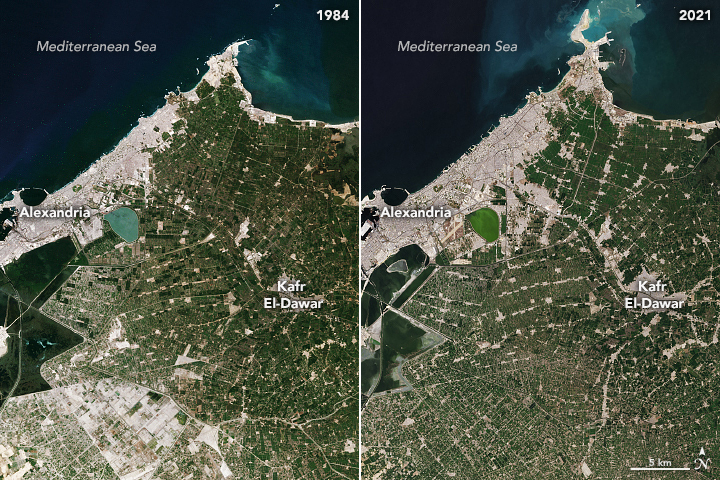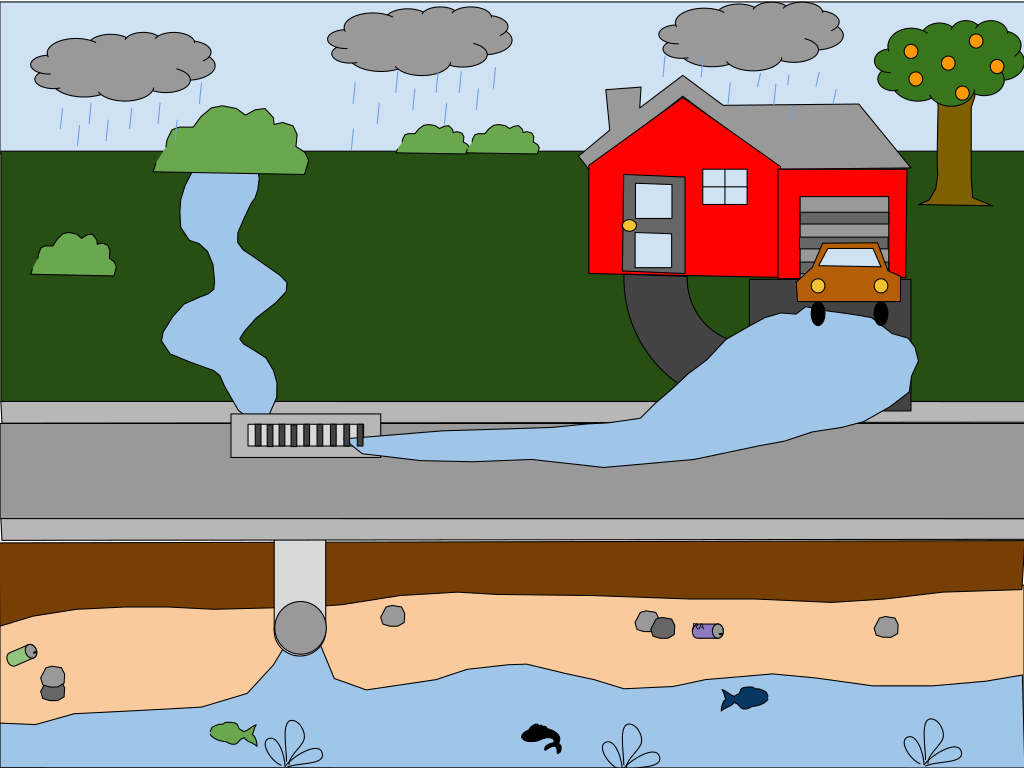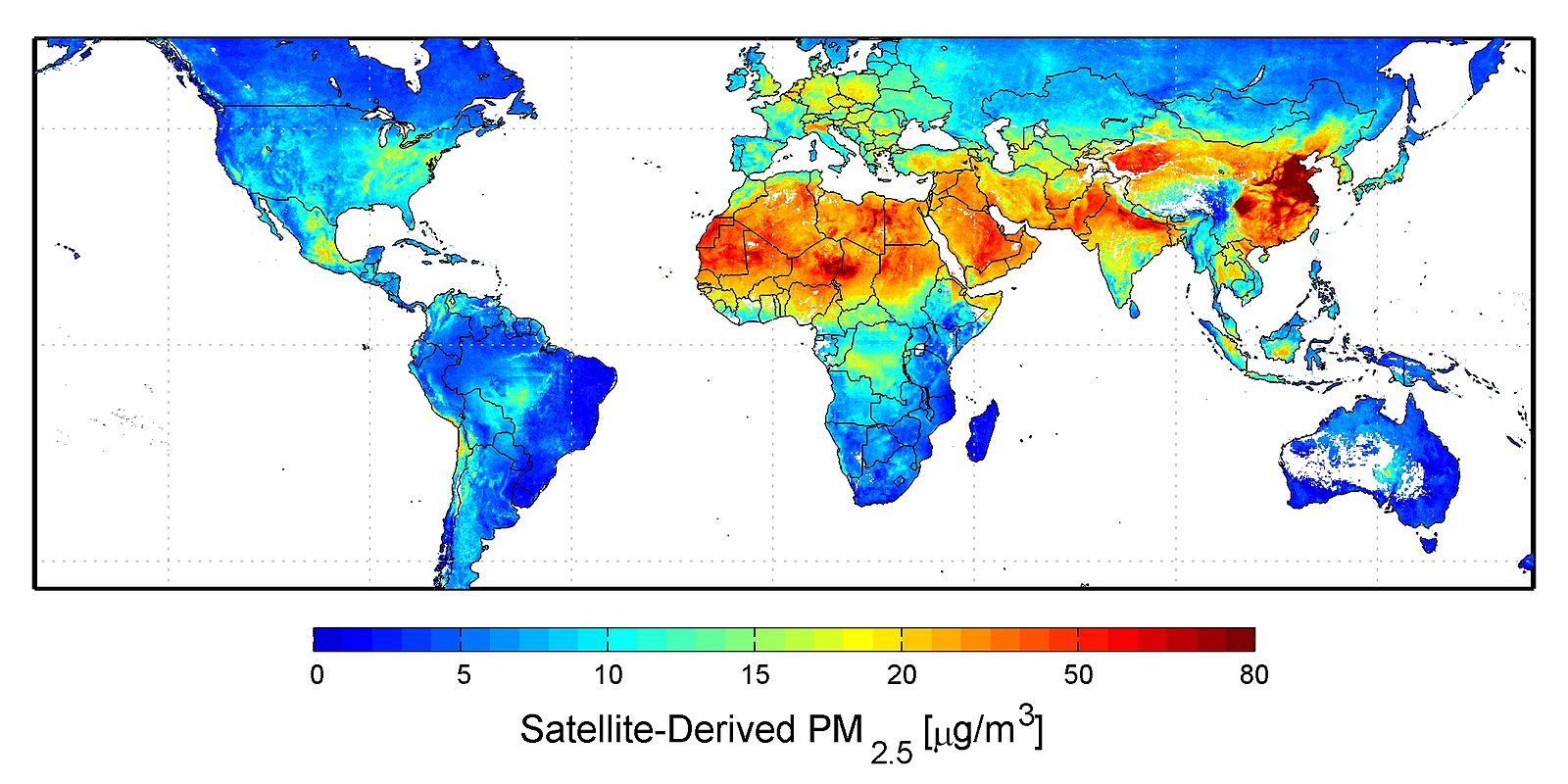IB Syllabus focus:
‘Urban and suburban growth can reduce farmland and ecosystems, alter water quality and river flows, and increase air pollution.’
Rapid urban expansion transforms landscapes and ecosystems, altering how people interact with natural systems. Understanding these environmental impacts helps explain trade-offs between development and sustainability.
Loss of Farmland and Natural Ecosystems
Reduction of Farmland
Urban expansion often occurs on fertile agricultural land. As cities grow outward, farmland is converted into housing, industry, and infrastructure. This threatens food security, particularly in countries heavily reliant on local agriculture.
Farmland: Land used for growing crops or raising livestock, often providing critical local food supplies.
The reduction of farmland can:
Decrease local food production and increase reliance on imports.
Lead to the fragmentation of agricultural landscapes, reducing efficiency and profitability.
Remove the cultural and economic identity tied to farming in many regions.
Destruction of Natural Ecosystems
Natural habitats such as wetlands, forests, and grasslands are cleared to make way for urban sprawl. This reduces biodiversity and damages ecosystem services, such as flood regulation and carbon sequestration.
Ecosystem Services: The benefits humans gain from ecosystems, including provisioning (food, water), regulating (climate, flood control), supporting (nutrient cycles), and cultural (recreation, aesthetics).
Loss of these services contributes to environmental instability, making cities more vulnerable to natural disasters.

Landsat images of Egypt’s Nile Delta in 1984 and 2021 show urban areas expanding (grey) over cropland (green). The comparison exemplifies farmland loss and habitat fragmentation driven by urban growth. The regional context goes beyond the syllabus location-agnostic scope but illustrates the process with high clarity. Source.
Alteration of Water Quality and River Flows
Water Pollution
Urban expansion increases the impermeable surface area (roads, buildings, pavements), reducing infiltration of rainwater. Runoff carries pollutants such as oil, heavy metals, and chemicals into rivers and lakes.

Diagram showing rainfall collecting contaminants from roofs, roads and driveways and entering storm drains that discharge to streams. This visual clarifies how impervious cover increases runoff volume and pollutant loads, degrading urban water quality and altering flow regimes. Minor extra labels (e.g., household sources) extend beyond the syllabus but aid understanding. Source.
Key consequences include:
Increased levels of nutrient pollution, causing eutrophication.
Higher concentrations of toxic substances harmful to aquatic organisms.
Reduced availability of clean drinking water for urban and rural populations.
Eutrophication: Excessive nutrient enrichment of water bodies, leading to dense plant growth and oxygen depletion, which harms aquatic life.
Changes to River Flows
When urban areas expand, rivers may be channelled, dammed, or diverted to make space for infrastructure. This alters natural flow regimes, reducing river resilience and affecting ecosystems downstream.
Consequences include:
Increased frequency of floods due to reduced floodplain absorption.
Disruption of fish migration and breeding cycles.
Lower groundwater recharge, reducing long-term water supply security.
Increased Air Pollution
Sources of Pollution
Urban expansion leads to more vehicles, construction, and energy demand. These activities release pollutants into the atmosphere, worsening air quality.
Main urban pollutants include:
Nitrogen oxides (NOx) from vehicle exhausts and industry.
Sulphur dioxide (SO₂) from burning fossil fuels.
Carbon monoxide (CO) from incomplete combustion.
Particulate matter (PM10 and PM2.5) from construction dust, traffic, and biomass burning.
Particulate Matter (PM): Solid or liquid particles suspended in the air. PM10 refers to particles ≤10 micrometres; PM2.5 refers to particles ≤2.5 micrometres, which penetrate deeply into lungs.
Expansion-related traffic and heating raise NOx, SO2, CO and particulate matter (PM10, PM2.5), degrading urban air quality.

Global map of PM2.5 (2001–2006) highlighting regions with higher fine-particle concentrations that often coincide with large urban and industrial areas. PM2.5 is the principal health-relevant fraction of particulate matter emphasized in the notes. This map is global rather than strictly urban but effectively contextualises the pollutant’s distribution. Source.
Impacts of Air Pollution
The environmental and social impacts are wide-ranging:
Damage to human health, increasing rates of asthma, bronchitis, and cardiovascular disease.
Acid deposition from NOx and SO₂, harming soils, vegetation, and buildings.
Reduced visibility and urban smog formation, lowering quality of life.
Interaction of Impacts
Combined Pressures
The three major impacts—loss of farmland/ecosystems, altered water systems, and air pollution—interact to create compounding problems:
Ecosystem destruction reduces resilience to air and water pollution.
Polluted waterways affect agricultural irrigation, worsening the impacts of farmland loss.
Air pollution contributes to climate change, which intensifies urban flooding and water scarcity.
Feedback Loops
Urban expansion creates feedback loops that can lock cities into unsustainable patterns:
Expanding suburbs lead to more car dependency, increasing emissions and air pollution.
Polluted rivers reduce local water supplies, requiring longer pipelines and more land conversion.
Destroyed ecosystems increase disaster risks, such as floods and landslides, forcing more urban planning interventions.
Approaches to Mitigation
Although this subsubtopic focuses on impacts, it is important to note that strategies can reduce harm:
Green belts around cities preserve farmland and ecosystems.
Sustainable drainage systems (SuDS) slow and filter stormwater, reducing river disruption.
Clean transport systems and renewable energy sources decrease air pollution.
These measures highlight that while urban expansion inevitably alters the environment, effective planning can minimise its most damaging effects.
FAQ
Urban expansion not only reduces farmland but also degrades remaining soils through compaction, sealing, and contamination. Compaction from heavy machinery and construction reduces soil porosity, making it less effective for infiltration and root growth.
Soil sealing from concrete and asphalt eliminates its natural functions entirely. Additionally, urban runoff can introduce pollutants such as hydrocarbons and heavy metals, which persist in soils and harm microbial communities.
Green spaces act as buffers against many negative effects of expansion. They:
Improve water infiltration and reduce runoff.
Absorb pollutants from air and water.
Provide habitats for urban biodiversity.
Well-integrated green belts and parks also reduce the heat island effect and preserve remnants of farmland within city limits.
Flood risk rises because impervious surfaces replace natural ground cover, limiting infiltration. Rainfall accumulates quickly, creating high surface runoff that overwhelms drainage systems.
Rivers modified for urban space often lose their floodplains, which naturally absorb excess water. With climate change intensifying rainfall events, expanded cities are more vulnerable to flash floods and waterlogging.
As farmland and vegetation are replaced by concrete and asphalt, less solar energy is absorbed by plants and more is stored in built materials.
This raises local temperatures, intensifying demand for cooling and increasing air pollution levels. Lack of evapotranspiration from plants further reduces natural cooling, creating microclimates that differ significantly from rural surroundings.
Fragmented ecosystems isolate species populations, limiting migration and genetic diversity. Over time, this reduces species resilience to environmental changes.
Smaller patches of habitat also face greater edge effects, where external pressures such as pollution, noise, and light penetrate deeper into ecosystems. This long-term fragmentation can lead to local extinctions and reduced ecological stability.
Practice Questions
Question 1 (2 marks)
State two environmental impacts of urban and suburban expansion.
Mark scheme:
1 mark for each correctly stated impact (maximum 2 marks).
Possible answers include:Loss of farmland.
Destruction of natural ecosystems.
Alteration of river flows.
Decline in water quality due to runoff.
Increase in air pollution.
(Any two valid impacts = 2 marks)
Question 2 (5 marks)
Explain how urban expansion can lead to changes in both water quality and river flows.
Mark scheme:
1 mark for noting increase in impermeable surfaces (e.g., roads, pavements).
1 mark for linking impermeable surfaces to increased runoff.
1 mark for identifying pollutants carried in runoff (oil, chemicals, heavy metals, nutrients).
1 mark for explaining how runoff affects water quality (e.g., eutrophication, toxicity for aquatic life).
1 mark for describing altered river flows (e.g., channelling, flooding, reduced floodplain absorption, disruption of ecosystems).
Maximum 5 marks.

